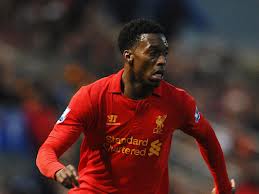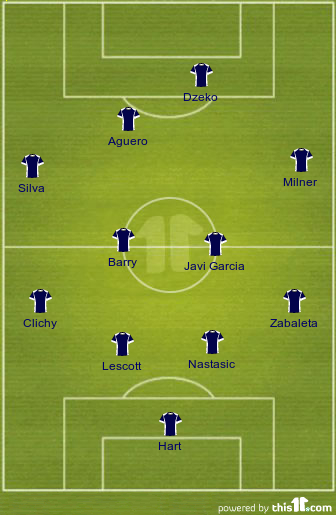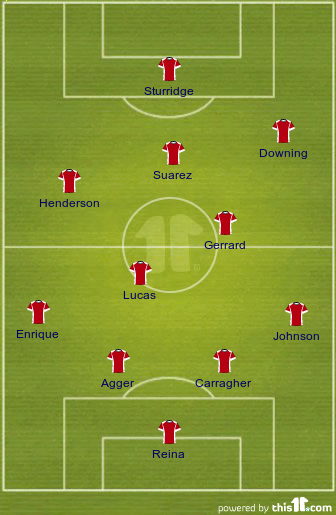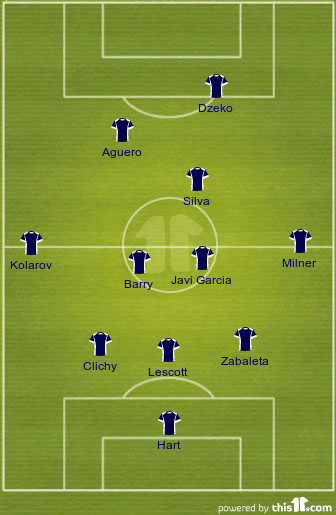Liverpool travelled to the Etihad Stadium on Sunday looking to build upon their good performance at Arsenal on Wednesday night, while Manchester City were hoping to close the gap at the top of the table after Manchester United’s win over Fulham on Saturday. Roberto Mancini was hoping that his side would be able to cope without key men Vincent Kompany and Yaya Toure and Liverpool would have been trying to produce a similar showing to their first-half performance at the Emirates, where they defended well and counter-attacked incisively.
Formations
Without the imperious Kompany in the centre of the defence, Mancini fielded Joleon Lescott and Matija Nastasić together for the first time in the Premier League whilst Javi Garcia kept his place alongside Gareth Barry in the absence of Yaya Toure. With four goals in his last four Premier League starts, Edin Dzeko led the line, with the mercurial Sergio Aguero buzzing around him.
For Liverpool, Jamie Carragher kept his place at centre-back after his midweek Man of the Match display, but this time the fully-fit Jose Enrique was preferred to Andre Wisdom. This meant that Glen Johnson could revert to his more natural right-back position and give Liverpool added balance at the back. Although this was the only change in personnel from the Arsenal game, Brendan Rodgers did swap Jordan Henderson and Luis Suarez around in attack. Perhaps mindful of Pablo Zabaleta’s tireless attacking from full-back, Rodgers started with Henderson on the left and played Suarez centrally behind Danny Sturridge.
First Half – City struggle to control the game while direct Liverpool break quickly and incisively
After David Silva drew a fine save out his compatriot Pepe Reina within one minute of kick off, it looked as if City would go on to dominate the ball and take the initiative in the game. This was not to be the case, however, and Mancini’s side were unable to create many significant chances in the first half. Much like they did against Arsenal, Liverpool held their shape, pressed the ball and broke quickly as soon as they won possession. It was clear that the two wide midfielders, Downing and Henderson, were tasked with supporting Suarez and Sturridge the second the Reds gained possession; it was these two who were the first to break clear of the City midfield at the transitions. Indeed, Liverpool – under their notoriously possession-obsessed manager – were noticeably direct. This is not to say that they played the long, high ball, rather they tried to get it to the feet of the front men as quickly as they could.
This plan was working effectively, and Suarez and Sturridge were often exploiting the space behind Garcia and Barry in the opening fifteen minutes, with the Uruguayan in particular having a series of good chances. It was City, though, who took the lead. Despite their seeming lack of imagination going forward, it only took one neat turn from Sergio Aguero to open the pitch up and within moments Dzeko had converted James Milner’s drilled cross. As the commentators were quick to point out, Liverpool were a goal down but did not deserve to be so.
It was Aguero who was the biggest threat to Reina’s goal in the first half, and the Argentinean continually pulled onto Jamie Carragher and tried to expose the 35 year-old’s lack of pace. He was unable to create many goal-scoring opportunities on his own, though; a testament to Carragher’s performance.
As we see so often, goals change games. This goal, however, changed neither Mancini’s gameplan nor Rodgers’. The Northern Irishman was clearly happy with the way his team were playing and within ten minutes they had scored a deserved equaliser through Danny Sturridge’s fizzing drive from the edge of the box. It was in fact the first time that Liverpool had really controlled the ball in City’s half but it was Javi Garcia’s poor touch which led to the space opening up for the English attacker.
Sturridge was the key man in the first half. He held the ball up exceptionally well, often twisting past one or two defenders in order to do so, and this allowed Liverpool to firstly relieve the pressure on their defence and secondly get players forward and into more threatening positions.
As the half wore on, it was noticeable that Johnson and Enrique were pushing further forward than Zabaleta and Clichy and this is perhaps indicative of the control Liverpool were starting to take.
Second Half – Mancini turns to 3-5-2 but City continue to struggle
The most notable tactical alteration of the game came in the 55th minute when Roberto Mancini ditched his trusted 4-2-3-1 in favour of the 3-5-2 he tried so unsuccessfully in the Champions League. With Kolarov on for Nastasic, Clichy and Zabaleta sat alongside Lescott at the back, whilst Milner moved to right wing-back.
Frankly, this didn’t work. One of the most interesting things about recent weeks is that, without Yaya Toure, Gareth Barry has being pushing further forward than usual. Although he has never been an attacking player, the England midfielder showed at Aston Villa that he has the potential to be a threat in advanced positions. Alongside Javi Garica, Barry clearly has more license to push forward and support the attacking players than he usually would. This was noticeable not only in Sunday’s game but also against QPR, where it was his close range shot which forced a fine save from Julio Cesar. By changing the system and moving David Silva into a more central position, Barry was restricted in his forward movement; he now had to cover his more exposed flanks as well as not get in the way of the Spanish playmaker.
City really struggled to create any chances of note, and Liverpool seemed to growing increasingly confident and assertive as the game went on. Unlike the Arsenal game, they were not pinned back into their own half and we able to advance and pressurise as a team. It was no surprise that Rodgers made no tactical changes in the entire game.
As Liverpool became more and more proactive, Steven Gerrard did what Steven Gerrard does best and crashed home a fine strike from range. It was a lead that his side deserved and at this point it looked more than likely that they would keep the lacklustre City at bay.
The only threat to the Reds’ defence was, once again, Sergio Aguero. The forward was the only player who ran at the Liverpool back-line and it was clear that if an equaliser was to come, he would be at the heart of it. This was indeed the case, as the former-Atletico Madrid man produced an astounding finish after Pepe Reina erroneously came off his line. It was a mistake from the Spaniard, but the finish must be admired. With the score even, the game became a cagey affair. Both sides went for a winner but with the game on the line neither team committed many men forward or created any clear-cut chances. That said, a Sturridge effort from 20 yards and a few late free-kicks suggest that if any team was to win the game, it would be Liverpool.
Conclusions
More question marks will be raised about Roberto Mancini. The Italian’s inability to change the system for the better once again reared its head in this closely fought game. After his side were stifled by an organised and efficient Liverpool, his switch to 3-5-2 only blunted his attack. If it weren’t for the individual talents of Sergio Aguero his team would have created very, very little. Brendan Rodgers, on the other hand, will once again be encouraged by his team’s performance away from home. Steven Gerrard and Lucas stayed compact and close together, not allowing players like Silva any space, and Sturridge and Suarez looked dangerous throughout. Liverpool’s fixtures appear to be considerably more winnable in the coming weeks and this performance will undoubtedly give his side added confidence going into those games.




